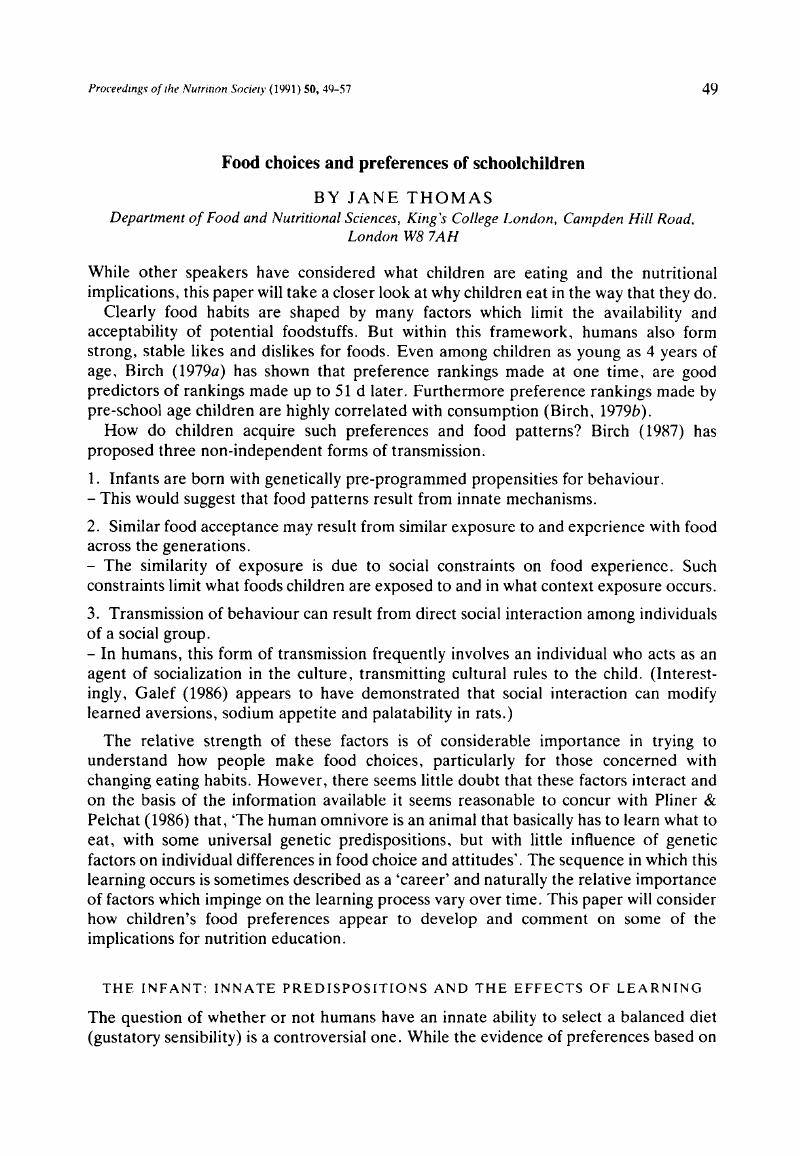Crossref Citations
This article has been cited by the following publications. This list is generated based on data provided by Crossref.
Lean, M. E. J.
and
McFarlane, Moira
1991.
Nutrition Education in Scottish Schools.
Proceedings of the Nutrition Society,
Vol. 50,
Issue. 1,
p.
45.
Ruxton, C. H. S.
Kirk, T. R.
Belton, N. R.
and
Holmes, M. A. M.
1993.
Micronutrient intakes in schoolchildren—is supplementation necessary?.
Journal of Human Nutrition and Dietetics,
Vol. 6,
Issue. 4,
p.
373.
Anderson, Annie S.
Macintyre, Sally
and
West, Patrick
1994.
Dietary patterns among adolescents in the West of Scotland.
British Journal of Nutrition,
Vol. 71,
Issue. 1,
p.
111.
Noble, Carol
and
Kipps, Michael
1994.
Implementing quantified guidelines for school meals.
International Journal of Hospitality Management,
Vol. 13,
Issue. 4,
p.
361.
Dennison, Catherine M.
and
Shepherd, Richard
1995.
Adolescent food choice: an application of the Theory of Planned Behaviour.
Journal of Human Nutrition and Dietetics,
Vol. 8,
Issue. 1,
p.
9.
Shepherd, Richard
and
Dennison, Catherine M.
1996.
Influences on adolescent food choice.
Proceedings of the Nutrition Society,
Vol. 55,
Issue. 1B,
p.
345.
Coulson, Neil
Eiser, J Richard
and
Eiser, Christine
1996.
Children's awareness of additives in food.
Health Education Journal,
Vol. 55,
Issue. 4,
p.
375.
Szajkowski, Z.
1996.
Magnesium, calcium and phosphorus contents in daily food rations in primary school children: Questionnaire and analytic studies.
Food / Nahrung,
Vol. 40,
Issue. 6,
p.
330.
Toporoff, Elanah G.
French, Simone A.
Story, Mary
Himes, John H.
Snyder, M. Patricia
DuBray, Maxine
Rock, Bonnie Holy
and
Hunsberger, Sally
1997.
Do Children Eat What They Say? Validity of Intended Food Choices Among Native American School Children.
Obesity Research,
Vol. 5,
Issue. 2,
p.
87.
SEAMAN, CLAIRE E.A.
BOWER, JOHN
and
FLEMING, MARK
1997.
Nutrition knowledge and lunchtime eating habits of secondary school children in Lothian.
Journal of Consumer Studies & Home Economics,
Vol. 21,
Issue. 3,
p.
259.
Barwise, T. P.
1997.
Children’s Food.
p.
126.
Jas, Pauline
1998.
Aspects of food choice behaviour in adolescents.
Nutrition & Food Science,
Vol. 98,
Issue. 3,
p.
163.
Epstein, Leonard H.
Myers, Michelle D.
Raynor, Hollie A.
and
Saelens, Brian E.
1998.
Treatment of Pediatric Obesity.
Pediatrics,
Vol. 101,
Issue. Supplement_2,
p.
554.
Douglas, Lesley
1998.
Children’s food choice.
Nutrition & Food Science,
Vol. 98,
Issue. 1,
p.
14.
Coulson, Neil S
Eiser, Christine
and
Eiser, J Richard
1998.
Nutrition education in the National Curriculum.
Health Education Journal,
Vol. 57,
Issue. 1,
p.
81.
Bunting, Grace
and
Freeman, Ruth
1999.
The influence of socio-demographic factors upon children's breaktime food consumption in North and West Belfast.
Health Education Journal,
Vol. 58,
Issue. 4,
p.
401.
Woodward, David R.
Cumming, Fiona J.
Ball, Peter J.
Williams, Heather M.
Hornsby, Helen
and
Boon, Judith A.
2000.
Urban‐rural differences in dietary habits and influences among Australian adolescents.
Ecology of Food and Nutrition,
Vol. 39,
Issue. 4,
p.
271.
Bower, John A.
and
Sandall, Louise
2002.
Children as consumers – snacking behaviour in primary school children.
International Journal of Consumer Studies,
Vol. 26,
Issue. 1,
p.
15.
Hart, K. H.
Bishop, J. A.
and
Truby, H.
2002.
An investigation into school children's knowledge and awareness of food and nutrition.
Journal of Human Nutrition and Dietetics,
Vol. 15,
Issue. 2,
p.
129.
Burchett, Helen
2003.
Increasing fruit and vegetable consumption among British primary schoolchildren: a review.
Health Education,
Vol. 103,
Issue. 2,
p.
99.



